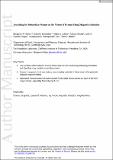Searching for Subsurface Oceans on the Moons of Uranus Using Magnetic Induction
Author(s)
Weiss, Benjamin P.; Biersteker, John B.; Colicci, Vittorio; Goode, Allison; Castillo‐Rogez, Julie C.; Petropoulos, Anastassios E.; Balint, Tibor S.; ... Show more Show less
Download10.1029-2021GL094758.pdf (1.541Mb)
Open Access Policy
Open Access Policy
Creative Commons Attribution-Noncommercial-Share Alike
Terms of use
Metadata
Show full item recordAbstract
The icy moons of Uranus may contain subsurface oceans. Such oceans could be detected and characterized using measurements of magnetic fields induced by Uranus' time-varying magnetospheric field. Here we explore this possibility for Uranus's five major moons, with a focus on Ariel. We find that the magnetic field at each moon is dominated by the synodic frequency with amplitudes ranging from ∼4 nT at Oberon up to ∼300 nT at Miranda. If these bodies contain oceans with sufficient thicknesses (>∼3–40 km) and conductivities (>2 S m−1) even underlying relatively thick (∼50 km) ice shells, the induced surface fields should have amplitudes exceeding the typical ∼1 nT sensitivity of spacecraft magnetometry investigations. Furthermore, the magnetic field variations at the moons span periods ranging from 1 to 103 h. These could enable long-term measurements to separately constrain ocean and ice thicknesses and ocean salinity.
Date issued
2021-09-27Department
Massachusetts Institute of Technology. Department of Earth, Atmospheric, and Planetary SciencesJournal
Geophysical Research Letters
Publisher
American Geophysical Union (AGU)
Citation
Weiss, B. P., Biersteker, J. B., Colicci, V., Goode, A., Castillo-Rogez, J. C., Petropoulos, A. E., & Balint, T. S. (2021). Searching for subsurface oceans on the moons of Uranus using magnetic induction. Geophysical Research Letters, 48, e2021GL094758.
Version: Author's final manuscript
ISSN
0094-8276
1944-8007